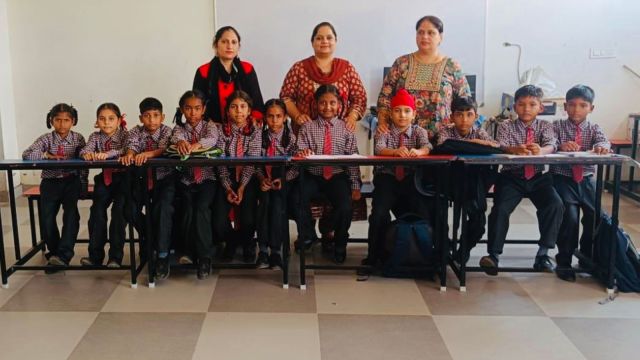For Navdeep Kaur, her mother struggled to manage everything alone as water entered their house. Gurnoor Singh felt scared that their entire house would be filled with water, with the ceiling leaking for days. When the floodwater entered their house, Jashandeep Kaur feared their house would collapse and worried about where they would go; they are very poor.
Stories like these brought forth children’s traumatic experiences of the devastating flood that ravaged Punjab when they returned to government schools on Tuesday, more than ten days after the flood-forced shutdown. Children from villages spoke their hearts out with their teachers and expressed that they were still feeling scared.

Class IV student Navdeep Kaur, who lives in a slum in Moga, said, “The ceiling of our house was leaking for days. We slept outside when it did not rain, but would move inside under the leaking ceiling when it rained. Water entered our house, and my mother struggled to manage everything alone. My father was a drug addict and used to beat my mother, so she left him. Now she is alone, taking care of everything. Our house is in a very bad condition after continuous rains.”

Story continues below this ad
A Class II student in Moga, Gurnoor Singh, whose father is a driver and mother works as a domestic help, said, “Our house has been leaking for days due to heavy rains. I felt scared that our entire house would be filled with water, but my parents covered the roof with layers of cement to plug the leakages.”
A Class IX student from Khatriwala village in Mansa district, Jashandeep Kaur, whose father works as a daily wager, said that she, along with her siblings, had moved to a relative’s place after their house developed cracks and was on the verge of collapse.
“The ceiling developed cracks. When water entered our house, we decided to move to our relatives’ place. We are still living there. Our family is very poor. When water entered our house, I thought about where we would go if the house collapsed. If it is gone, then we won’t be able to construct a new house. We were sad. We never saw so much water before.”
“We helped our parents in transplanting the paddy in the water. We enjoyed them and earned money. We always waited for the rainy season. We always enjoy rain, but now we are seeking help from others to repair our house,” she said.
Story continues below this ad
Teachers say the devastating flood has traumatised students, especially tiny tots, and they will take time to come out of it.
Sunita Rani of Gulaba Bhaini village in Fazilka district said she had sent her daughter Amandeep, a Class V student, to a relative’s place as their house was still under 3 feet of water. “Today, we got our children back home in a boat. Schools have reopened, but are flooded. Our paddy crops in seven acres were washed away. The house is completely damaged. How will we recover from these losses?” she asked.
Amandeep said, “I have seen the 2023 floods, but that was not like this. This time, our entire house has been flooded. It’s scary.”
Teachers say students whose houses or areas are not flooded have also been affected psychologically by watching flood news on TV and social media.

Story continues below this ad
Harsh Goyal, teacher at Government Primary School, Datt Road in Moga, said, “A flood is not just a natural disaster, it leaves behind countless stories, pain and deep lasting wounds. It impacts the tender minds of children when villages and towns are inundated. When floodwater starts receding and life starts returning to normalcy, school becomes a place where children reunite. This reunion is not merely physical; it’s also an opportunity to listen to stories they have withheld in their hearts.”
“The faces of children returning to school are often marked by odd silence and sadness. The sparkle of joy in their eyes is missing. As they sit on the benches, their focus is not on the book, as their minds replay horrific images of the floods,” added Goyal.
“Many children are still going through the trauma. Activities like games, art and music should be used to lighten their minds,” said another teacher.
At least 61 schools in Gurdaspur district, 29 in Pathankot, 50 in Sangrur, 30 in Fazilka, 36 in Ferozepur, and all schools in Ajnala division of Amritsar district are still closed due to the worst flood situation in these districts.











